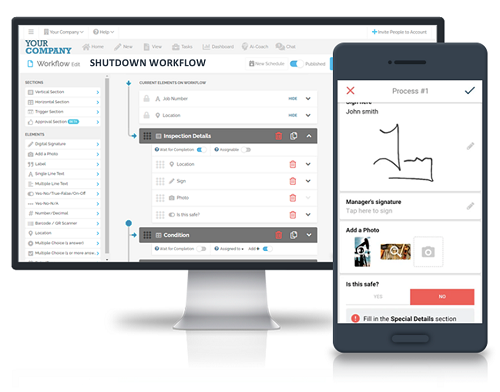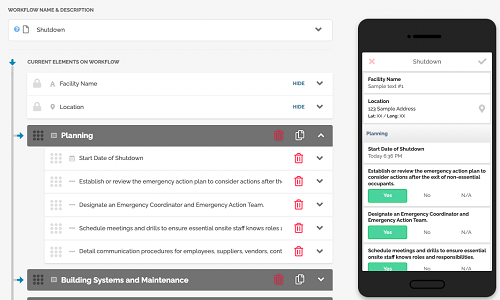For a large manufacturing facility with established operating procedures, it’s easy to assume that a standard shutdown project will progress safely and smoothly each time.
However, this isn’t necessarily the case.
Mistakes happen even at this level as Martin Smith (a director at Orbit) found out when one of his frontline workers drove an overloaded truck down a steep 10-degree slope under instruction from his supervisor.
This is why a comprehensive shutdown/turnaround form with in-depth checklists is a must-have tool for companies and especially large manufacturers who have significant cost implications for mishaps.
In Smith’s case, a quick checklist review by his frontline workers would have highlighted the obvious risks of an overloaded truck, averting the entire accident.
We’ve gathered more information on shutdown forms including how to draft and implement them. As we go over these ideas, you’ll get to understand:
- How a shutdown/turnaround form minimizes downtime and production loss
- Why a real-time turnaround form is more effective for downtime management
- How full disclosure makes a shutdown form more useful for performance reviews
But first, let’s define a shutdown/turnaround form.
What Is a Shutdown/Turnaround Form?
A shutdown/turnaround form is a comprehensive document outlining the processes and procedures that should be followed during the shutdown period.
The form is created in advance and serves as a guide for all stakeholders, including production staff, maintenance teams, contractors, and management.
The shutdown/turnaround form outlines the scope of work, timelines, resources required, and risk assessments.
This serves as a guideline that ensures all stakeholders are on the same page in terms of execution, minimizing downtime and production loss while maintaining worker safety and the budget.
So, why shut down the facility anyway? Is it necessary?
Reasons for Shutdown/Turnaround in Large Manufacturing Facilities

Large manufacturing facilities shut down for two reasons:
- Planned outages to facilitate routine equipment repairs, technology upgrades, and checkups for manufacturing safety and efficiency
- Unplanned shutdowns to address emergencies such as industrial accidents and leakages, equipment failure, and legal directives
Naturally, planned outages are advantageous as they contribute to the efficiency and productivity of the manufacturing facility, which ultimately leads to cost savings in the long term.
Take the instance of a technology upgrade incorporating digital workflows for large facilities. The resulting speed and accuracy of operations after the shutdown will yield more productivity and efficiency than what was lost during the downtime.
Unexpected shutdowns, on the other hand, increase costs via lost raw materials, expensive equipment repairs and overhauls, and in some instances (such as when there’s an emission) fines.
They also lower a manufacturing facility’s productivity because the shutdown period isn’t defined, so the production delay can last longer than would be the case with a planned outage.
Take the instance of an unexpected legal directive to shut down due to an accident. Operations can only resume after approval and inspection by the governing authority, which takes months.
A classic example of this scenario is when aircraft manufacturers are ordered to seize operations after a plane crash.
This difference explains why a large manufacturing facility would rather have planned outages for maintenance and improvements, which prevents unplanned shutdowns.
So, how does a shutdown/turnaround form help with this?
Importance of a Shutdown/Turnaround Form
As we noted earlier, the turnaround form is a critical facility shutdown planning document, outlining the scope of the work, budgets, timelines, and safety procedures.
This helps manufacturers execute the planned downtime without hitches in the following ways.
1. Ensuring Safety
The form communicates to all the stakeholders including frontline workers all the safety measures in place before work commences and provides an opportunity for the team to check their compliance as they work.
This helps minimize accidents, reduces injuries, and ensures that the facility complies with safety and health regulations.
It also helps the facility run efficient plant maintenance or upgrades because of the minimal disruptions from accidents and injuries.
With a shutdown/turnaround form software such as FAT FINGER, you can take downtime safety a step higher with real-time frontline worker coaching.
The application uses machine learning for industrial safety to give suggestions to your frontline team on operation procedures.
So, for example, if a worker is checking off a list of downtime tasks involving equipment inspections and is inputting readings of various equipment. The app is able to notify him when a reading is abnormal and suggests contacting a supervisor as per standard operating procedures.
This encourages compliance by your workers and ensures safety during the planned shutdown.
2. Minimizing Downtime and Production Loss
The turnaround form outlines the timeline for the entire shutdown project with time allocations for each task.
This guides the workers on how long each task should take and keeps them from spending too much time on any given job. It also prevents delays for sequential tasks that can’t commence before their primary tasks.
As a result, the manufacturing facility is able to maintain its shutdown schedule and avoid extra losses to productivity due to extended downtime.
3. Effective Budget Management
The turnaround form outlines the resources needed for each downtime task including labor, equipment, and finances.
This leads to improved decision-making in manufacturing shutdowns as it helps the facility prioritize downtime tasks and avoid over-committing resources to low-value tasks such as non-essential cleaning.
Consequently, this frees up more labor, equipment, and finances for the critical high-value tasks that improve productivity such as worker training and equipment upgrading.
That said, what are the main elements of a well-crafted shutdown/turnaround form?
Key Elements of a Shutdown/Turnaround Form

A well-crafted shutdown/turnaround form needs the following elements to ensure a safe and efficient execution.
1. A Detailed Inventory of Maintenance/Replacement Components
A detailed inventory of components defines the scope of work for the entire shutdown or the “what needs doing.”
This perspective makes it easier to break down the job into multiple tasks or work packages with checklists and performance indicators to track progress, for instance:
- What sections of the facility need maintenance or upgrading?
- How many pieces of equipment are in each section?
- How many components are involved?
The responses to these questions help formulate the checklists, which serve as progress indicators for the entire shutdown project.
And with a digital solution such as the FAT FINGER app, this process becomes super easy with its drag-and-drop approach to scoping your downtime.
Simply select the components under maintenance from the extensive list within the app, and customize them with functional details such as hierarchy and resource allocations including labor, tools, and finances.
With this detailed breakdown of your downtime, it’s easy to set up the next crucial element in your shutdown/turnaround form, which is clear timelines.
2. Clear Work Schedules
A well-defined turnaround form needs clear timeliness to ensure proper time use throughout the downtime project and minimal disruption to production at the facility.
This becomes easier with a breakdown of all the tasks involved with a hierarchy of importance.
Simply allocate more time to the most crucial high-value functions and just enough for the less important but helpful tasks. This enables you to effectively cover the entire downtime workload with the least amount of time so production can restart sooner.
For example, critical equipment disassembly and maintenance tasks will need more time allocation than non-essential cleaning.
With a clearly defined project scope and timeline, what could go wrong? And what are the contingencies? This is the next crucial element of the turnaround form.
3. Potential Hazards and Risks
Identifying the possible hazards and risks of the downtime project and then developing mitigation strategies plus contingencies helps minimize disruption to the project.
This ensures that the manufacturer avoids accidents, stays within the established cost limits, and prevents prolonging the disruption to operations and productions via downtime.
With the breakdown of tasks from the inventory details, highlighting the possible risks also becomes easier.
All you need to do is list the foreseeable common problems associated with each task, for example, labor disruptions or tool failure. Then specify the mitigation strategies for these scenarios. Perhaps, stand-in crews, emergency response teams, and spare tools.
With the specifics of the turnaround form established, planning for the downtime is equally important. So, how do you go about this?
Planning for Shutdown/Turnaround
Planning for shutdown/turnaround activities is another critical step in ensuring the smooth and efficient execution of maintenance works in a large manufacturing facility.
A comprehensive approach involves incorporating communication strategies for all stakeholders, monitoring progress, and making adjustments as needed.
This creates a cohesive workflow with easy changeovers between teams because of the intra-communication.
It also encourages improvements as monitoring progress exposes cases of underperformance such as missed task deadlines and directs effort towards solving them.
1. Incorporating Communication Strategies for All Stakeholders
An effective communication strategy involves regular updates and progress reports to everyone on the various work packages, from the production staff to the maintenance team to contractors and management.
This facilitates smooth changeovers between teams and speeds up time-sensitive scenarios such as emergency responses and contingency executions.
The best communication channels will be real-time and collaborative such as the FAT FINGER app with its easy sharing feature.
Once set up, the software displays a digital workflow of the shutdown project to all stakeholders with signed comments from different team leads on their progress.
It also enables photo attachments to help visualize the progress of each work package to all stakeholders.
So, for instance, the maintenance team can attach progress photos indicating the disassembly stage, replacement fittings stage, and the reassembly of various equipment pieces.
2. Incorporating Monitoring and Adjustments Strategies
Continuous monitoring enables a facility to identify potential issues and make the necessary adjustments that ensure progress and timeliness.
For instance, a missed task deadline directs the facility to deploy extra personnel and adjust the labor allocation for future shutdown forms.
Incorporating these monitoring and adjustment strategies involves the following aspects:
- Safety Checklists: These verify that the frontline workers are following the established operational safety procedures such as wearing personal protection equipment.
They also direct a facility toward worker training adjustments if the checklists indicate noncompliance
- Progress Checklists: These review key performance indicators such as the task deadlines and whether they’re progressing as planned.
They also direct a facility toward timeline adjustments if deadlines are consistently missed.
- Quality Checklists: These evaluate the execution of each work package, looking at details such as whether the job stayed within the established budget of personnel and finances.
They also direct a facility toward training adjustments and tool upgrades if the checklists indicate a low quality of execution.
So, with the shutdown form drafted and the planning in place, how do you execute it?
Implementation of the Shutdown/Turnaround Form

The implementation stage is where the rubber meets the road and where the success of the shutdown project manifests.
At this point, the following aspects are critical to achieving the desired outcomes.
1. Strict Adherence to the Shutdown Plan
You must strictly adhere to the shutdown plan developed during the drafting stage to avoid delays, cost overruns, and other problems.
This necessitates that your project team has a clear understanding of roles, responsibilities, and deadlines, and is well-trained on execution via the plant shutdown checklist.
The good news is that you don’t have to draft them yourself and can take advantage of operational excellence tools such as FAT FINGER, featuring a library of shutdown and maintenance checklists.
The library is fully customizable to match your industrial maintenance procedures via an easy drag-and-drop control panel. Therefore, you can add custom elements such as an emergency evacuation drill and an emergency action team.
2. Addressing Potential Issues and Making Necessary Adjustments
During this stage, it’s essential to keep an eye on potential issues that may arise and promptly address them, for instance, unforeseen equipment breakdowns, weather disruptions, or staffing issues.
Your team will need to be well-trained to execute the contingencies addressing these challenges and ensure the smooth running of the shutdown project.
3. Continuous Safety Inspections and Risk Assessments
The safety of your workers and equipment is paramount during the implementation stage. So, you’ll need to conduct frequent safety inspections and risk assessments to identify and mitigate hazards.
This will allow you to make adjustments to the plan for future shutdown forms to prevent a recurrence, which brings us to our next implementation must-do, full documentation.
4. Documenting All Work Completed
You’ll need to keep an accurate record of all the completed tasks during the shutdown job for post-project analyses, which improve future shutdowns.
To achieve this, you’ll need to include any changes to the initial plan such as budget allocations, timelines, and personnel deployment with comments on context.
For instance, why these changes occurred, the outcome, and the implications for future shutdown projects.
This level of accuracy and detail makes the shutdown form more informative and effective as an analysis and improvement tool.
Handle Your Shutdowns Effectively With FAT FINGER

So there you have it. Shutdown/Turnaround forms as comprehensive downtime management tools every large manufacturing facility needs.
However, we understand that not everyone has the time to draft one and that’s what led us to develop the FAT FINGER app.
“With FAT FINGER, we have full visibility into all of our assets during the shutdown and have access to SOPs, maintenance history records and more in one simple app. I highly recommend it!”
– Doris Smith, Plant Engineering Lead
It’s an extensive workflow management tool that helps you draft custom shutdown forms with its easy drag-and-drop function and an extensive list of work components.
So, all you have to do is drag in the components related to your project (work order), set the timelines, assign teams, and the app generates a shutdown form featuring multiple-choice checklists.
Here is a brief video on how to carry out a safety observation using the app:
But drafting is just the first step. The FAT FINGER app also helps you manage the shutdown with nifty features such as:
- A comprehensive view of all your assets during the shutdown
- Real-time progress updates on the workflow including photos
- A detailed post-project analysis of your performance
It’s why 84% of users report improved overall effectiveness with 38.75 hours reclaimed per week.
Contact us today to learn more about how the FAT FINGER app can optimize your downtime.
Share on LinkedIn:



